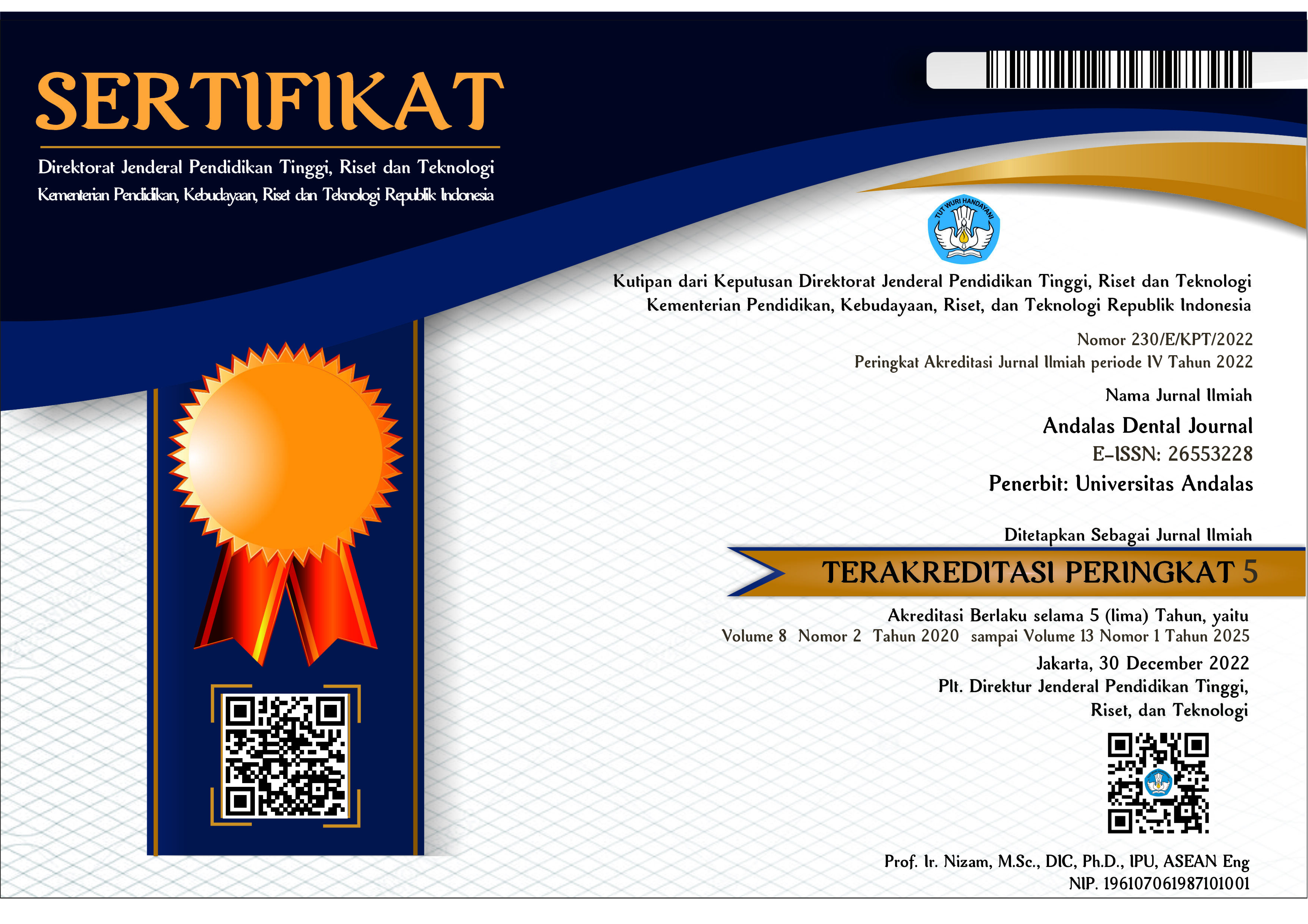Xerostomia dan Hiposalivasi pada Pasien Lansia di Rumah Sakit Gigi dan Mulut Universitas Andalas
Abstract
The number of elderly people in the world continues to increase annually, including in Indonesia. Over more than a decade(2010–2021), the percentage of the elderly has climbed by at least 3%, reaching 10.82 %. Age-related conditions that negatively affect the physical and mental well-being of the elderly, such as xerostomia and hyposalivation, can lead to a decline in oral function Purpose:This study aims to determine the condition of xerostomia and hyposalivation in elderly patients at the Andalas University Dental and Oral Hospital (RSGM UNAND). Methods:This study usedcross-sectional design, using a total sampling technique involving 35 elderly patients with full edentulous conditions who came to UNAND General Hospital within 3 months. Xerostomiais carried out using a questionnaire that has been tested for its validity and rehabilitation, then salivary flow rate are carried out using the unstimulated saliva collection method to determine the condition of hyposalivation The data was analyzed by computerized by usingspearman test to analyze the relationship between the condition of xerostomiaand hyposalivationang sociodemographic aspects.Results:41.4%of patients had hyposalivation, thus xerostomia affected all patients (62.9% exhibiting low and 37.1% highcomplaint). Theaverage saliva flow rate was 0.51±0.303, and there was no correlation between saliva flow rate and sociodemographic aspects. (p>0.05).Conclusion:Some elderly patients with full edentulous conditions experience hyposalivation and xerostomia conditions caused by lack of salivary production due to aging factors
References
Dibello, V., Zupo, R., Sardone, R., Lozupone, M., Castellana, F., Dibello, A., Daniele, A., De Pergola, G., Bortone, I., Lampignano, L., Giannelli, G., & Panza, F. Review Oral frailty and its determinants in older age: a systematic review. 2021.www.thelancet.com/
Furtado, G. E., Caldo, A., Rieping, T., Filaire, E., Hogervorst, E., Teixeira, A. M. B., & Ferreira, J. P. Physical frailty and cognitive status over-60 age populations: A systematic review with meta-analysis. In Archives of Gerontology and Geriatrics.2018; (Vol. 78, pp. 240–248). Elsevier Ireland Ltd. https://doi.org/10.1016/j.archger.2018.07.004
Badan Pusat Statistik. Statistik Penduduk Lanjut Usia 2022. (n.d.). www.freepik.com
Castellana, F., Lampignano, L., Bortone, I., Zupo, R., Lozupone, M., Griseta, C., Daniele, A., De Pergola, G., Giannelli, G., Sardone, R., & Panza, F. Physical Frailty, Multimorbidity, and All-Cause Mortality in an Older Population From Southern Italy: Results from the Salus in Apulia Study. Journal of the American Medical Directors Association, 22(3), 598–605. https://doi.org/10.1016/j.jamda.2020.12.026
Cefalu, C. A. Theories and Mechanisms of Aging. In Clinics in Geriatric Medicine. 2011; (Vol. 27, Issue 4, pp. 491–506). https://doi.org/10.1016/j.cger.2011.07.001
Kugimiya, Y., Watanabe, Y., Ueda, T., Motokawa, K., Shirobe, M., Igarashi, K., Hoshino, D., Takano, T., Sakurai, K., Taniguchi, Y., Kitamura, A., Shinkai, S., & Hirano, Rate of oral frailty and oral hypofunction in rural community-dwelling older Japanese individuals. Gerodontology. 2020; 37(4): 342–352. https://doi.org/10.1111/ger.12468
Oura, R., Mäntylä, P., Saarela, R., & Hiltunen, K. Oral hypofunction and association with need for daily assistance among older adults in long-term care. Journal of Oral Rehabilitation. 2020; 49(8): 823–830. https://doi.org/10.1111/joor.13345
Uchida, Y., Sato, Y., Kitagawa, N., Furuya, J., Osawa, T., Isobe, A., Terazawa, M., Hatanaka, Y., & Shichita, T. Comparison of oral hypofunction tests and determination of reference values for a subjective masticatory function test. BMC Oral Health. 2022; 22(1). https://doi.org/10.1186/s12903-022-02252-9
Duan, Y., Qi, Q., Cui, Y., Yang, L., Zhang, M., & Liu, H. Effects of dietary diversity on frailty in Chinese older adults: a 3-year cohort study. BMC Geriatrics. 2023; 23(1). https://doi.org/10.1186/s12877-023-03875-5
Iwasaki, M., & Hirano, H. Decline in Oral Function and Its Management. In International Dental Journal. 2022; 72(4): S12–S20). Elsevier Inc. https://doi.org/10.1016/j.identj.2022.06.010
Tanaka, T., Hirano, H., Ohara, Y., Nishimoto, M., & Iijima, K. Oral Frailty Index-8 in the risk assessment of new-onset oral frailty and functional disability among community-dwelling older adults. 2021.
Chalermsri, C., Rahman, S. M., Ekström, E. C., Ziaei, S., Aekplakorn, W., Satheannopakao, W., & Muangpaisan, W. Dietary diversity predicts the mortality among older people: Data from the fifth Thai national health examination survey. Archives of Gerontology and Geriatrics. 2023; 110. https://doi.org/10.1016/j.archger.2023.104986
Gale, C. R., Westbury, L., & Cooper, C. Social isolation and loneliness as risk factors for the progression of frailty: The English Longitudinal Study of Ageing. Age and Ageing. 2018; 47(3): 392–397. https://doi.org/10.1093/ageing/afx188
Shwe, P. S., Ward, S. A., Thein, P. M., & Junckerstorff, R. Frailty, oral health and nutrition in geriatrics inpatients: A cross-sectional study. Gerodontology. 2019; 36(3): 223–228. https://doi.org/10.1111/ger.12397
Agostini BA, Cericato GO, Silveire ER, Nascimento GG, Costa KS, Thomson WM, Demarco FF. How common is drymouth? Systematic review and meta-regression analysis of prevalence estimates. Brazililian Dental Journal. 2018; 29(6); 606-18.
Santos IC, Dias AR, Maximiano J, Manso AC, Polido M, Proenca L, Mendes JJ, Canhao H. Hyposalivation and xerostomia: Prevalence and associated factors in the elderly. Elderly Med Sci Forum. 2023; 22(33); 1-3
Hasegawa Y, Sakuramoto A, Sugita H. Relationship between oral environment and frailty among older adults dwelling in a rural Japanese community: a cross-sectional observational study. BMC Oral Health. 2019; 19 (1): 1-6.
Hakeem, F. F., Bernabé, E., & Sabbah, W. Association between oral health and frailty: A systematic review of longitudinal studies. Gerodontology. 2019; 36 (3) 205–215). Blackwell Munksgaard. https://doi.org/10.1111/ger.12406
Chalittikul, W., Kassim, S., & Sabbah, W. (2020). The association between number of teeth and physical function limitation among older adults in the USA. Gerodontology, 37(4), 389–394. https://doi.org/10.1111/ger.12489
Cruz-Moreira, K., Alvarez-Cordova, L., González-Palacios Torres, C., Chedraui, P., Jouvin, J., Jiménez-Moleón, J. J., & Barrios-Rodríguez, R. Prevalence of frailty and its association with oral hypofunction in older adults: a gender perspective. BMC Oral Health. 2923; 23(1). https://doi.org/10.1186/s12903-023-02824-3
Copyright (c) 2024 Gunawan Gunawan, Ivony Fitria, Desy Purnama Sari

This work is licensed under a Creative Commons Attribution-ShareAlike 4.0 International License.















